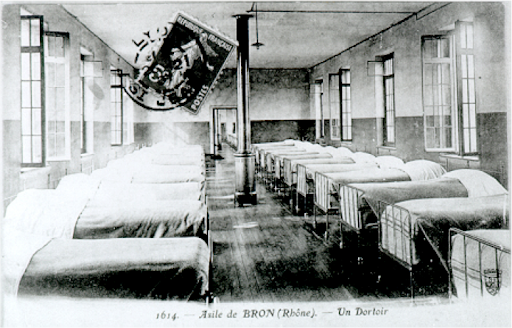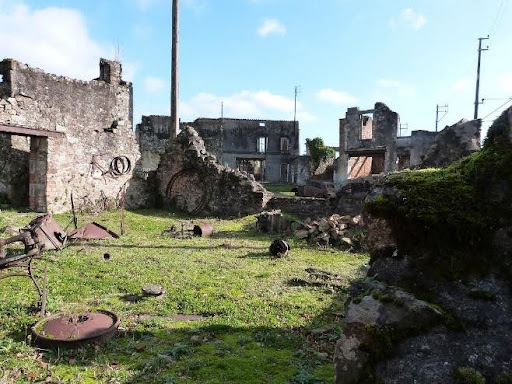Marie Derrien's research sheds light on the way in which psychiatric care systems have adapted over the course of history and to forms of social control. Drawing on hospital, administrative and judicial archives, the historian of psychiatry examines the logic of internment, the mechanisms for preventing, identifying and diagnosing mental disorders, and the mechanisms for monitoring the people concerned.

As a teenager, Marie Derrien was predestined for medicine. "With a scientific baccalaureate, the idea was to become an emergency doctor or pediatrician," she explains. In the end, she opted for literary studies. But when it came to choosing her first research subject, she had no hesitation in turning to the history of medicine. "In this field, it was psychiatry that attracted me most.
This choice was influenced by several encounters, in particular that with Isabelle Von Bueltzingsloewen, a historian of psychiatry known for her work on famine in psychiatric hospitals during the Second World War. Under her guidance, she began her research in Lyon.
"From the moment I dipped my nose into psychiatric archives, particularly medical files, I discovered stories and trajectories. It fascinated me, and I told myself that it was with these archives that I wanted to continue my research."

Medical files from the Rhône departmental psychiatric hospital: these documents provide invaluable testimony from soldiers and their families about the war and its psychological repercussions. Archives of the Centre hospitalier Le Vinatier, photo featured in: Marie Derrien, "La tête en capilotade". Les soldats de la Grande Guerre internés dans les hôpitaux psychiatriques français de 1914 aux années 1980"Les Carnets du LARHRA [En ligne], 1 | 2016, online July 12, 2018, accessed January 09, 2025.
These archives, she points out, are exceptionally rich. Unlike other fields of medicine, psychiatry produces highly detailed nominative files, due to legal obligations to monitor patients. These are "archives of the intimate", where it is possible to follow the life paths of individuals, often overshadowed by traditional historical accounts.
"Delusions colored by war".
One day, while consulting patient files at the Vinatier psychiatric hospital, she noticed a repeated annotation on several folders: ART. 55. It intrigued her. After investigating, she realized it was a reference to Article 55 of the Military Pensions Act, which allows hospitalization costs to be deducted from veterans' pensions. This simple detail became the cornerstone of her thesis on the internment of soldiers after the Great War.

Bron Asylum dormitory, circa 1900. This type of collective dormitory, typical of the large French psychiatric asylums, is a reminder of the conditions in which soldiers suffering from mental disorders were interned after the Great War (Photo from the Ferme du Vinatier Documentation Center).
These soldiers, shattered by the war, exhibit delusions marked by visions of the trenches. " We no longer delude ourselves about the factory, we delude ourselves about the trench", she explains. These delusions were not recognized as manifestations of psychic trauma, because at the time, this concept did not yet exist. "There was no talk of post-traumatic stress disorder (PTSD) at the time. We were talking about delusions colored by the war."
But the war also transformed care practices. To cope with the influx of soldiers suffering from mental disorders, the army set up medical-military centers, where some of them were cared for without being interned. This innovation foreshadowed contemporary dehospitalization arrangements.
Old age and madness
In 2016, after defending her thesis, Marie Derrrien met Mathilde-Rossigneux-Méheust, lecturer at the Université Lumière Lyon 2 and specialist in the history of the working classes, gender and old age. Together, they decided to launch an investigation into an institutional arrangement experimented with in July 1956, within the Préfecture de la Seine: the transfer of "old people" interned in the department's psychiatric hospitals to the Villers-Cotterêts retirement home in the Aisne.
By studying the setting up of the system, the discussions between the care and assistance institutions, the effects of this initiative on the displaced populations and all the difficulties raised by this administrative bricolage, they bring together the history of local public action, psychiatry and old age.
Their work thus seeks to better understand the challenges posed by the care of a population hitherto little taken into account by the social state and rarely studied by historians. It continues with other research, notably on the family colonies for the insane. Established at the turn of the 20th century in Dun-sur-Auron (Cher) and Ainay-le-Château (Allier), these were pioneering experiments in home care for mentally ill men and women, particularly the elderly.
Their operation is based on the care provided by women known as "nannies", who take in these "boarders" for a meagre daily allowance. Continuing their joint work, the two researchers are currently preparing a book on mental health and ageing, which looks at the issue from a historical perspective, from the 19th to the 20th century. It will shortly be published by Editions du Seuil.
From the ruins of the past to the traces of trauma
In 2017, Marie Derrien became a lecturer at the University of Lille. Stéphane Michonneau, professor of contemporary history and head of the research laboratory she had just joined, invited her to join the team he had set up to work on the social and political uses of war ruins. Babeth Robert, director of the Centre de la Mémoire d'Oradour-sur-Glane, was one of the team members.
This encounter led Marie Derrien to take an interest in this Haute-Vienne commune where, on June 10 1944, 643 people were massacred by the SS Das Reich division. More than just a pile of stones, the ruined village has become a symbol of collective memory. But beyond the stones, the story of Oradour also finds an echo in psychiatric archives.

The ruins of the village of Oradour-sur-Glane (Haute-Vienne), burned during the massacre of June 10, 1944 by the 2nd SS Das Reich division (Photo: Thérèse Gaigé, via Wikimedia Commons, CC0).
Marie Derrien joins forces with historian Fanny Le Bonhomme, Senior Lecturer at the University of Poitiers, to investigate the psychological after-effects of the massacre. Collaborative workshops are also being organized with psychiatrists and psychologists, to cross-reference historical and clinical analyses.
"Ruins are more than collapsed walls. They leave traces in memories and care practices."
Surveillance without internment
Since 2024, Marie Derrien has also been coordinating a project funded by the Agence nationale de la recherche (French National Research Agency) on the reporting of mental disorders in Paris between 1940 and 1980. Drawing on the archives of the Préfecture de Police in Paris, she and a multidisciplinary team of ten researchers, archivists and doctors are analyzing these reports, often made by relatives, janitors or neighbors, which do not necessarily lead to hospitalization.
"These reports show that the definition of madness is not only a matter for doctors, but also for those around them and their tolerance thresholds when faced with gestures, behaviour and attitudes that deviate from what is, in a given context, defined as the norm.
Light, not repair
Through her research, the historian of psychiatry pursues a clear objective: to bring to light trajectories erased by history. From the asylum to the trenches, from the destroyed village of Oradour to the reports from the prefecture, her work gives substance to forgotten lives, eclipsed by official accounts. "The historian is not a vigilante. I'm not here to re-establish the truth or to repair anything, but to shed light.
She stresses the importance of interdisciplinary dialogue with psychiatrists, police officers and carers. "I learn a lot from these exchanges.
What advice would you have liked to have received at the start of your career? "Keep going. Believe in this path. And above all, don't hesitate to play as a team."
To find out more :
- Julien, E., Derrien, M., & De Oliveira, M. (2022). La vie d'après : Les retours de la Grande Guerre (312 p.). Presses universitaires du Septentrion.
- Derrien, M. (2021). La clinique psychiatrique départementale d'Esquermes: Une initiative pionnière de prise en charge des troubles mentaux en milieu urbain. Hôpital, ville et citoyenneté, 185-197.
- Derrien, M. (2020). Treating the incurable? L'expérience des colonies familiales et la réforme de l'assistance aux aliénés en France (1892-1939). Revue d'histoire moderne & contemporaine, 67(1), 24-43. https://doi.org/10.3917/rhmc.671.0024
- Derrien, M. (2018). A new role for asylums? Soldiers' experiences of institutionalization during World War I in France. Psychiatrie im Ersten Weltkrieg, 187-196.
- Derrien, M. (2018). 1914-1918: A pioneering moment of psychiatric dehospitalization in France? Experimental practices and transformations of the asyllic model during the Great War. In La fin de l'asile? Histoire de la déshospitalisation psychiatrique dans l'espace francophone au XXe siècle (pp. 39-50).
- Derrien, M. (2016). "Entrenched from life": The impossible reintegration of traumatized French veterans of the Great War. In Psychological trauma and the legacies of the First World War (pp. 193-214). Cham: Springer International Publishing.
- Derrien, M. (2015). Eliminate or recover? L'armée française face aux fous du début du XXe siècle à la Grande Guerre. Le Mouvement social, 253(4), 13-29.
- Derrien, M. (2015). "La tête en capilotade": Les soldats de la Grande Guerre internés dans les hôpitaux psychiatriques français (1914-1980) (Doctoral dissertation, Université Lumière Lyon 2, France).


